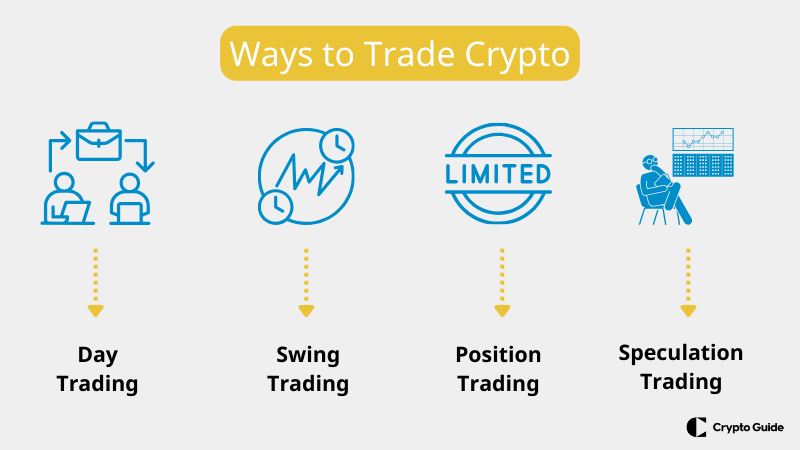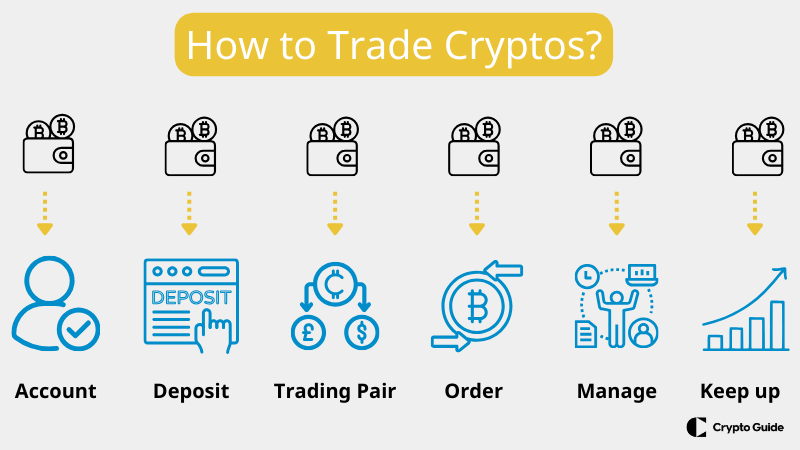How to Trade Cryptocurrency | A Beginners Guide
In this beginner's guide to trading cryptocurrency, we'll walk you through the process of buying and selling digital assets on a crypto exchange. Cryptocurrencies use cryptography for security and are typically decentralized, meaning they're not controlled by governments or banks.
This guide is designed to help beginners understand the basics of cryptocurrency trading.
Table of content
What is Cryptocurrency Trading?
Cryptocurrency trading involves the exchange of digital or virtual tokens on specialized platforms. These tokens, known as cryptocurrencies, utilize cryptographic techniques to ensure security. They operate in a decentralized manner, free from government or financial institution oversight.
How Does Cryptocurrency Spot Trading Work?
Cryptocurrency spot trading works by buying and selling cryptocurrencies on a cryptocurrency exchange. When you buy a cryptocurrency, you are essentially exchanging your fiat currency (e.g., USD, EUR, JPY) for the cryptocurrency. When you sell a cryptocurrency, you are essentially exchanging the cryptocurrency back for your fiat currency.
There are two main types of orders that you can use in cryptocurrency trading:
- Market orders are executed immediately at the current market price.
- Limit orders specify the price at which you want to buy or sell a cryptocurrency. Your order will be executed if the market price reaches your limit price.
Ways to Trade Cryptocurrency
There are four main types of cryptocurrency spot trading:
- Day trading involves buying and selling cryptocurrencies within a short period of time, typically hours or minutes.
- Swing trading involves buying and selling cryptocurrencies over a longer period of time, typically days, weeks, or months.
- Position trading involves holding a cryptocurrency for an extended period, typically months or years.
- Speculation trading involves buying and selling cryptocurrencies based on speculation about future price movements.

Day Trading
Day trading is a short-term trading strategy that involves buying and selling cryptocurrencies within a short period, typically hours or minutes. Day traders aim to profit from small price fluctuations in cryptocurrencies by rapidly buying and selling them.
Pros
- High potential for profits: Day trading has the potential to generate high profits, as it is possible to profit from small price fluctuations.
- High liquidity: Cryptocurrency markets are highly liquid, making it easy to buy and sell cryptocurrencies quickly and easily.
- Low transaction costs: Cryptocurrency exchanges typically have low transaction fees, which can reduce the overall cost of day trading.
Cons
- High risk: Day trading is a high-risk strategy, with a high likelihood of losing money.
- Requires a lot of skill: Day trading requires a deep understanding of technical analysis and market psychology to identify profitable trading opportunities.
- High stress: Day trading can be very stressful, as traders need to make quick decisions under pressure.
- Requires a lot of time: Day trading requires significant time and effort to monitor the market and make trading decisions.
Day trading can be a profitable strategy for experienced traders who are comfortable with high risk and have much time to dedicate to the market. However, it is important to note that day trading is not suitable for everyone, and there is a high likelihood of losing money.
Swing Trading
Swing trading is a medium-term trading strategy that involves buying and selling cryptocurrencies over a slightly longer period of time, typically days, weeks, or months. Swing traders identify trends in the cryptocurrency market and aim to profit from these trends by buying cryptocurrencies when they are undervalued and selling them when they are overvalued.
Pros
- Lower risk than day trading: Swing trading is less risky than day trading, as traders do not need to make as many frequent trades.
- More time to identify and analyze trends: Swing traders have more time to identify and analyze trends in the cryptocurrency market, increasing their chances of making profitable trades.
- Reduced stress: Swing trading is less stressful than day trading, as traders do not need to make quick decisions under pressure.
Cons
- Lower potential for profits: Swing trading does not have the same potential for profits as day trading, as traders are not making as many trades.
- Requires a deeper understanding of market trends: Swing traders need to have a deeper understanding of market trends to identify profitable trading opportunities.
- Trading fees can eat into profits: Swing trading can be more expensive than day trading, as traders are typically charged higher transaction fees.
Swing trading can be a profitable strategy for traders who are comfortable with moderate risk and have a moderate amount of time to dedicate to the market. It is a less stressful and more manageable approach than day trading, allowing traders to take advantage of larger market trends. However, it is important to note that swing trading is not suitable for everyone, and there is a risk of losing money.
Position Trading
Position trading is a long-term trading strategy that involves holding a cryptocurrency for an extended period of time, typically months or years. Position traders believe in the long-term potential of cryptocurrencies and are willing to ride out short-term fluctuations to benefit from the overall growth of the market.
Pros
- Lower risk than day trading and swing trading: Position trading is considered to be the least risky type of cryptocurrency trading. For one thing, position traders are less affected by short-term fluctuations and instead, they rely on the long-term growth of the cryptocurrency market.
- More potential for profits: Position trading can generate higher profits than day trading and swing trading, as traders are holding cryptocurrencies for longer periods of time.
- Less time commitment: Position traders do not need to spend as much time monitoring the market and making trading decisions as day traders or swing traders.
Cons
- Reduced ability to react to market shifts: Position traders are less able to react to sudden market shifts or changes in sentiment, which can lead to missed opportunities.
- Requires a strong understanding of the cryptocurrency market: Position traders need to have a strong understanding of the cryptocurrency market, including its fundamentals, trends, and risks.
- More vulnerable to market downturns: Position traders are more vulnerable to market downturns, as they have their capital tied up in cryptocurrencies for a longer period of time.
Position trading can be a profitable strategy for traders comfortable with moderate to high risk and have a long-term investment horizon. It is a less demanding approach than day trading or swing trading but requires a deeper understanding of the cryptocurrency market and trends. However, it is important to note that position trading is not suitable for everyone, and there is a significant risk of losing money.
Speculation Trading
Speculation trading is a high-risk trading strategy that involves buying and selling cryptocurrencies based on speculation about future price movements. Speculators attempt to anticipate upcoming events or changes in the cryptocurrency market that could impact prices.
Pros
- Potential for high profits: Speculation trading has the potential to generate high profits, as traders can capitalize on large price swings.
- Ability to react to market shifts: Speculation traders can react quickly to sudden market shifts or changes in sentiment, which can lead to profitable opportunities.
- Less time commitment: Speculation trading can be a relatively low-time commitment strategy, as traders do not need as much time monitoring the market as position or swing traders.
Cons
- High risk: Speculation trading is considered the riskiest type of cryptocurrency trading. This is because traders rely on their judgment to anticipate future price movements, which can be very difficult.
- Requires a strong understanding of market psychology: Speculation trading requires a strong understanding of market psychology, as traders need to predict how investors will react to news and events.
- More volatile than other trading strategies: Speculation trading is more volatile than other trading strategies, as traders are exposed to the full range of price movements in the cryptocurrency market.
- More likely to result in losses: Speculation trading is more likely to result in losses than other trading strategies, as it is based on speculation rather than fundamental analysis.
Speculation trading can be a profitable strategy for experienced traders who are comfortable with high risk and have a strong understanding of market psychology. It is a high-stakes approach that requires careful planning and discipline. However, it is important to note that speculation trading is not suitable for everyone, and there is a significant risk of losing money.
Understand the Market
Understanding the market is crucial when learning how to trade cryptocurrency, especially for beginners. The cryptocurrency market is highly volatile and complex, making it essential to have a thorough understanding of the factors that drive price movements to make informed trading decisions.
How the Cryptocurrency Market Works
The cryptocurrency market operates globally on a decentralized, peer-to-peer network, allowing users to buy, sell, and trade directly. Resistant to control by any single entity, it provides openness, accessibility, and transparency through public blockchain records.
Increasing liquidity facilitates smoother transactions, but the market is known for its high volatility, posing both risks and opportunities. Less regulated than traditional markets, it comprises diverse participants, and market metrics track trends within a broader ecosystem of exchanges, wallets, and payment processors.

Market Trends and Analysis
The cryptocurrency market sees a surge in adoption, with businesses, institutions, and individuals driving heightened demand and expanding market capitalization. Institutional investors contribute liquidity and stability, legitimizing cryptocurrencies as a recognized asset class.
Developers innovate new applications, enhancing cryptocurrency utility and further fueling adoption. Global regulatory developments shape the market's landscape. Despite notable price volatility, the cryptocurrency market offers trading opportunities for risk-tolerant investors.
Analytically, technical analysis involves chart scrutiny for trends, while fundamental analysis assesses intrinsic value based on technology, use cases, team, and community. Sentiment analysis gauges public opinion, and ecosystem and regulatory analyses offer insights.
Continuous market evolution requires ongoing research and vigilance for informed investment decisions.
Factors That Affect Cryptocurrency Prices
Several key factors shape the cryptocurrency market's volatility. Market dynamics of supply and demand drive price fluctuations, with increased adoption boosting demand and raising prices.
Regulatory developments play a vital role, in attracting or deterring institutional investors based on regulations. Technological advancements can elevate prices through innovation or lower them due to security concerns. News and events, positive or negative, significantly impact sentiment and prices.
Speculation and hype can lead to short-term increases without fundamental support. Large holders (whales) influence prices through significant transactions, and market psychology, driven by emotions like fear and greed, also plays a role.
These interconnected factors make it challenging to predict their collective impact on cryptocurrency prices.
Basics of Cryptocurrency Trading
To effectively navigate the market, familiarize yourself with the fundamentals of basic crypto trading principles:
- Market Structure and Dynamics: Cryptocurrency markets are decentralized, operating on a peer-to-peer network without intermediaries. While resistant to censorship, this adds complexity for traders.
- Volatility and Risks: Cryptocurrency prices are highly volatile, offering profit opportunities but also posing risks of significant losses. Manage risk exposure and comprehend volatility impact before entering the market.
- Exchanges and Wallets: Exchanges facilitate buying, selling, staking and trading cryptocurrencies, while wallets store essential private keys for asset access and management.
- Order Types and Execution: Market orders transact at the current market price, limit orders set price boundaries, and stop-loss orders automatically sell at predetermined levels to limit losses.
- Technical and Fundamental Analysis: Technical analysis studies historical price charts, while fundamental analysis evaluates intrinsic cryptocurrency value based on technology, use cases, team, and community.
- Diversification and Risk Management: Mitigate risk by diversifying your cryptocurrency portfolio across projects and using risk management strategies like stop-loss orders and position sizing.
- Continuous Learning and Research: Stay updated with market trends, news, and developments through regular reading, webinar attendance, and networking to refine trading strategies.
- Start Small and Gradually Increase: As a beginner, begin with small investments, gradually increasing trading capital with experience to manage risk and avoid emotional decisions.
Understanding Fees and Costs
Cryptocurrency transaction fees, charged by miners, vary based on network congestion and desired transaction speed. Exchanges impose trading, deposit, withdrawal, margin trading, and cold storage fees. Wallets may charge for transactions, withdrawals, staking, or lending. Some offer free services, while others levy percentage or flat fees. Hidden fees, like markups or spreads, exist; comparing platforms ensures optimal deals.

How to Trade Cryptocurrencies?
Investing in cryptocurrency for beginners requires understanding key market aspects and trading fundamentals. This section guides you through essential topics like market structure, exchanges, order types, and analysis techniques, equipping you to navigate cryptocurrency trading complexities.
- Choose a Cryptocurrency Exchange: The first step is to choose a cryptocurrency exchange. Many different exchanges are available, so it is important to research and find one that is reputable, and secure and offers the cryptocurrencies you want to trade. Some popular exchanges include Coinbase, Binance, and Kraken.
- Create an Account: Once you have chosen an exchange, you must create an account. This usually involves providing your name, email address, and password. Some exchanges may require verifying your identity by providing a photo ID or other documentation.
- Deposit Funds: Before you can start trading, you will need to deposit funds into your account. Most exchanges accept deposits in fiat currencies such as US Dollars, Euros, or Japanese Yen. Exchanges also accept deposits in cryptocurrencies.
- Select a Trading Pair: A trading pair is a pair of cryptocurrencies that you can trade against each other. For example, the trading pair BTC/USD means that you can buy Bitcoin with US Dollars and sell Bitcoin for US Dollars.
- Place an Order: There are two main types of orders: market orders and limit orders. Market orders are executed immediately at the current market price. Limit orders specify the price you want to buy or sell a cryptocurrency. Your order will be executed if the market price reaches your limit price.
- Manage Your Trades: Once you have placed an order, you must monitor your trades and manage your risk. This may involve setting stop-loss orders to automatically sell your cryptocurrency if the price falls below a certain level.
- Keep Up with Market News: The cryptocurrency market is highly volatile, so keeping up with market news and developments is essential. This will help you make informed trading decisions and avoid costly mistakes.
Final Words on Crypto Trading
Approaching cryptocurrency trading cautiously is essential due to its complexity and volatility. Prioritize understanding market dynamics, risks, exchanges, wallets, order types, analysis techniques, and ongoing learning. Begin with small investments, gradually increasing as experience grows, and avoid emotional decisions.
Diversify portfolios to mitigate risk, comprehend and minimize transaction fees, and stay informed about hidden costs. Continuous research and learning, staying updated through articles, webinars, and networking, are crucial.
FAQ About Crypto Trading
Is crypto trading good for beginners?
Cryptocurrency trading for beginners can be lucrative, but it's with risks. As with any investment, there is a possibility of losing money. Before you start trading crypto, it's essential to do your research and understand the risks involved.
What is the minimum amount to start trading in crypto?
No minimum amount is required to start trading crypto, but you will need to factor in the fees associated with trading and the potential for losses. It's also essential to have a solid understanding of the market before you start investing.
Is day trading crypto worth it?
Is day trading crypto worth it? Day trading is a high-risk strategy that involves buying and selling cryptocurrencies within a short period. This can be a way to make quick profits, but it's also highly volatile, and you could lose a lot of money if you're not careful.
Which crypto is best for day trading?
There is no one “best” cryptocurrency for day trading. However, some cryptocurrencies are more volatile than others and may be better suited for this type of trading.
Can you make $100 a day with crypto?
Making $100 a day with crypto day trading is possible, but it takes work. You'll need to have a lot of skill and experience, and you'll need to be able to manage your risks carefully.



